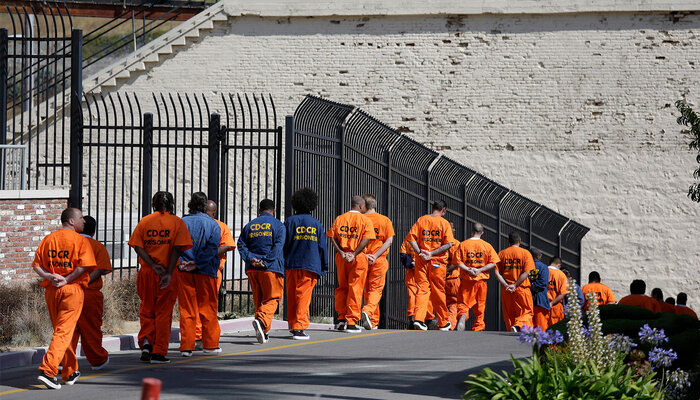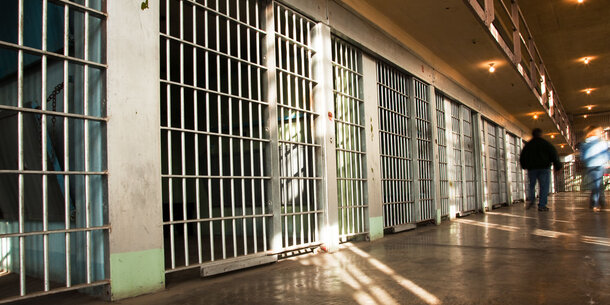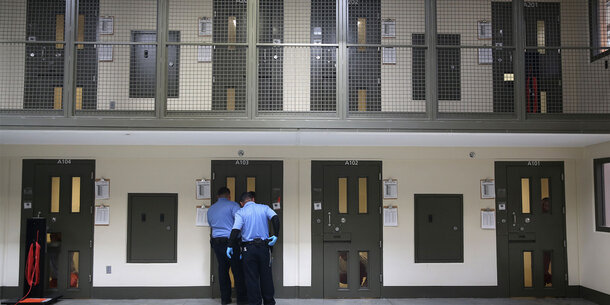This was first published by the American Bar Association’s magazine, Human Rights.
Today, as you read this article, there are almost 2 million people locked away in one of the more than 5,000 prisons or jails that dot the American landscape. While they are behind bars, these incarcerated people can be found standing in line at their prison’s commissary waiting to buy some extra food or cleaning supplies that are often marked up to prices higher than what one would pay outside of those prison walls. Many incarcerated people rely on electronic tablets to email a friend or family member, take an online class, or listen to music downloaded on the device. They will pay for these services and sometimes even the device. If they want to call a friend or family member, they need to pay for that as well. And almost everyone who works at a job while incarcerated, often for less than a dollar an hour, will find that the prison has taken a portion of their salary to pay for their cost of incarceration. This is not a scene from a dystopian science fiction novel but the reality for those trapped behind bars and for the millions of their family members who are on the hook for paying these fees.
How Did This Happen?
As the number of people sentenced to jails and prisons has skyrocketed, government agencies have found themselves unable to pay for the associated costs. While the nation’s incarcerated population peaked in 2009, decades of deepening mass incarceration’s hold on the nation resulted in runaway costs. In fact, the Urban Institute estimates that states and local governments spent $82 billion on corrections in 2019. To offset these costs, policymakers have justified legislation authorizing an ever-growing body of fees to be charged to the people (and, as a result, often their families) in prison and jail by claiming some fees, such as medical fees, will deter unnecessary visits that overtax correctional medical systems. These policymakers and government officials also know that this captive population has no choice but to foot the bill for the government’s own increasing costs of jail and prison administration and that if they can’t be made to pay, their families can. In fact, a 2015 report led by the Ella Baker Center for Human Rights, Forward Together, and Research Action Design found that in 63 percent of cases, family members on the outside were primarily responsible for court-related costs associated with conviction; when broken down further into which family members were primarily responsible for the costs, 83 percent were women.
Rutgers sociology professor Brittany Friedman has written extensively on what is called “pay-to-stay” fees in American correctional institutions. In her 2020 article titled, “Unveiling the Necrocapitalist Dimensions of the Shadow Carceral State: On Pay-to-Stay to Recoup the Cost of Incarceration,” Friedman divides these fees into two categories: (1) room and board and (2) service-specific costs. Fees for room and board—yes, literally for a thin mattress or even a plastic “boat” bed in a hallway, a toilet that may not flush, and scant, awful tasting food—are typically charged at a “per diem rate for the length of incarceration.” It is not uncommon for these fees to reach $20 to $80 a day for the entire period of incarceration. The second category, what Friedman refers to as “service-specific costs,” includes fees for basic charges such as copays or other costs for seeing a doctor or nurse, programming fees, email and telephone calls, and commissary items.
In 2014, the Brennan Center for Justice documented that at least 43 states authorize charging incarcerated people for the cost of their own imprisonment, and at least 35 states authorize charging them for some medical expenses. More recent research from the Prison Policy Institute found that 40 states and the federal prison system charge incarcerated people medical copays.
It’s also critical to understand how little incarcerated people are paid for their labor in addition to the significant cut of their paltry hourly wages that corrections agencies take from their earnings. Nearly two-thirds (65 percent) of incarcerated people work behind bars. According to the Prison Policy Initiative, those who work regular jobs in prisons such as maintaining the grounds, working in the kitchen, and painting the walls of the facilities earn on average between $0.14 and $0.63 an hour. Those who are lucky enough to find jobs working for the state’s correctional industries, such as making furniture for other government agencies, make on average between $0.33 and $1.41 an hour. Arkansas and Texas don’t pay incarcerated workers at all, while Alabama only pays incarcerated workers employed by the state’s correctional industry.
How Expensive Are These Fees?
To stay in touch and send money to pay fees and buy commissary items, many incarcerated people and their families rely on a technology company called JPay, a Florida-based company owned by the private equity firm Platinum Equity Partners. JPay is one of the main providers of communication and financial services to incarcerated people. JPay also sells prison-safe electronic tablets that allow incarcerated people to listen to music, compose and send emails, and play games.
Correctional agencies make money from contracts with companies such as JPay. For example, if someone sends an incarcerated person in Florida $20 online, they will end up paying $24.95. The $4.95 fee goes to JPay, and JPay sends a portion of the profit to the Florida Department of Corrections at a rate of $2.75 per money transfer. In Maine’s Hancock County Jail, JPay charges $12.95 if you put $200.01–$300.00 on an incarcerated person’s account. In Florida’s Avon Park Correctional Institution, the same transaction costs $13.95.
Medical Fees
Dallas County charges incarcerated people a $10 medical care fee for each medical request they submit. In Texas prisons, those behind bars pay $13.55 per medical visit, despite the fact that Texas doesn’t pay incarcerated workers anything. Texas is one of a handful of states that doesn’t pay incarcerated people for their labor.
Telephone Calls, Video Communications, and Emails
In Kentucky’s McCracken County Jail in Paducah, it costs $0.40 a minute for a video call; this translates into $8.00 for each 20-minute video call. Long-distance telephone calls are $0.50 a minute, but if someone doesn’t have money in their account and needs to call collect, long distance in-state calls are $2.50 connect fee plus $0.35 a minute, and long distance out-of-state calls are $3.95 connect fee plus $0.50 a minute. Kentucky currently charges the highest rate in the country for a 15-minute phone call, costing incarcerated people between $5.70 and $9.99.
For those who need to use email, JPay charges $2.35 for five emails for people in the Texas prison system ($0.47 an email). An attachment to the email requires an extra $0.47. JPay charges even more to communicate with those in the Sublette County Jail in Wyoming, where five emails cost $2.50 ($0.50 an email).
Commissary Fees
People in Florida prisons pay $1.70 for a packet of four extra-strength Tylenol and $4.02 for four tampons. And with inflation, commissary items are priced higher than ever. For example, according to the Kentucky Center for Investigative Reporting, incarcerated people in Kentucky experienced a 7.2 percent rise in already-high commissary prices in July 2022. Researchers noted that a 4.6-ounce tube of Crest toothpaste, which costs $1.38 at the local Walmart, is $3.77 at the prison commissary. And a three-ounce Speed Stick deodorant was $4.84, compared to $1.98 at Walmart.
Room and Board Fees
In Gaston County, North Carolina, incarcerated individuals who participate in state work release may make more than the state’s $0.38 an hour maximum pay, but they pay the jail a daily rate based on their yearly income of at least $18 per day and up to $36 per day. In fact, Brennan Center research indicates that almost every state takes a portion of the salary that incarcerated workers earn to compensate the corrections agency for the cost of feeding, housing, and supervising them.
These room and board fees are found throughout the nation’s jails and prisons. Michigan laws allow any county to seek reimbursement for expenses incurred in relation to a charge for which a person was sentenced to county jail time—up to $60 a day. Winnebago County, Wisconsin, charges $26 a day to those staying in its county jail. On average, Wisconsin counties charge a pay-to-stay fee of $13 a day (about $390 a month).
Inefficiency of the Practice
Asking those caught up in our criminal legal system to support government agencies is an inefficient way for the government to raise revenue. Because many low-income people can’t pay their debt, billions of dollars in fines and fees go unpaid every year. The Fines and Fees Justice Center found national court debt totaling $27.6 billion in 2021. And a 2019 report released by the Brennan Center found that from 2012 to 2018, Florida, New Mexico, and Texas amassed a total of almost $1.9 billion in uncollected court debt. This debt is made up of millions of tiny debts owed by people who may never be financially equipped to pay them off.
Modest Reforms
While there is still significant work to do to reduce the burden of these fees on people pulled into our justice system and their families, there are glimmers of hope that the government is committed to changing some of these practices. For example, in January, President Joe Biden signed into law the Martha Wright-Reed Just and Reasonable Communications Act of 2022, which clarifies that the Federal Communications Commission (FCC), which regulates interstate and international communications, can implement limits for fees on audio and video calls inside corrections facilities. The FCC must still go through a rule-making process to cap the rate of prison and jail phone calls.
And since 2019, both Illinois and New Hampshire have repealed their “pay-to-stay” laws that charged incarcerated people for their room and board in prison. For many years in Illinois, the Department of Corrections sued formerly incarcerated people for the cost of their incarceration in an attempt to reimburse taxpayers. In practicality, the state tended to only ask for payment from formerly incarcerated people once they learned that the person may have had a settlement or an inheritance. And in 2022, Connecticut revised its law, requiring incarcerated people to pay room and board only after conviction for serious crimes, such as murder, and only after $50,000 of incarceration costs accrue.
But these reforms are still far too few. States across the country need to repeal laws that allow correctional agencies to charge incarcerated people for their room and board. These agencies also need to reduce the prices of commissary items and eliminate copays for medical care behind bars. Further, states should ensure that none of their government agencies are receiving any sort of pass-through, kickback—you name it—for contracting with for-profit firms that provide money transfer and communication services to those behind bars.
If we really care about ensuring that those who emerge from the maze of the nation’s criminal legal system are best poised to rejoin their communities, we will eradicate as many of these fees as we can.






